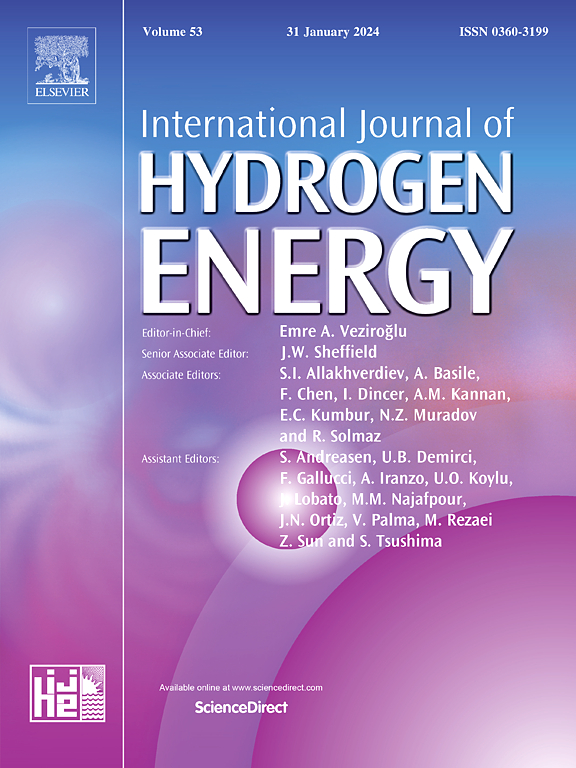光发酵产氢的光谱研究
IF 8.3
2区 工程技术
Q1 CHEMISTRY, PHYSICAL
引用次数: 0
摘要
紫色非硫细菌的生物氢生产通常依赖于红外光激发细菌叶绿素a。然而,可见波长的作用,特别是红色和蓝色,以及类胡萝卜素的贡献仍然不明确。在本研究中,我们首次使用乳清渗透物中的乳糖对荚膜红杆菌和红螺旋菌进行了四种LED光谱的统一比较。在冷白光、红外和目标光谱led下进行的小规模测试(50 mL)显示,冷白光led的H2产量最高(8.23 mmol H2 (L.day))。值得注意的是,单独的目标光谱LED产生了显著的H2(5.76±0.14 mol H2/mol乳糖),表明明显的类胡萝卜素激发可以在最小的BChl α激发下驱动生产。可见波长可以更均匀地散射,有利于非搅拌系统,而单独的红外线在细胞沉淀时表现不佳。缩放到2.1 L搅拌平板反应器,将生产率提高到18.64 mmol H2 (L.day) (3.26% LCE),使用Cool white LED作为光源。将光照强度提高到5000 lx,并更新一半的培养基,进一步将产量提高到26.93 mmol H2 (L.day) (4.49% LCE),同时保持最佳SOLR (~ 4.8 g乳糖/ gVS.h)。最后,双逻辑模型和改进的Gompertz模型准确地描述了多相H2积累,为优化复杂的光发酵系统提供了一个强大的框架。这项工作强调需要定制光谱,反应器设计和过程控制,以最大限度地提高生物氢产量。本文章由计算机程序翻译,如有差异,请以英文原文为准。
Insights of light spectra on biohydrogen production by photo-fermentation
Biohydrogen production by purple non-sulfur bacteria typically relies on infrared light to excite bacteriochlorophyll a. However, the roles of visible wavelengths, especially red and blue, and the contribution of carotenoids remain poorly defined. In the current study, it was performed the first unified comparison of four LED spectra in a co-culture of Rhodobacter capsulatus and Rhodospirillum rubrum using lactose from milk whey permeate. Small‐scale tests (50 mL) under Cool White, Infrared, and Targeted-Spectrum LEDs revealed that Cool White LEDs achieved the highest H2 productivity (8.23 mmol H2 (L.day)). Remarkably, the Targeted Spectrum LED alone yielded significant H2 (5.76 ± 0.14 mol H2/mol lactose), demonstrating that pronounced carotenoid excitation can drive production with minimal emission for BChl ɑ excitation. The visible wavelengths can scatter more uniformly, benefiting non‐stirred systems, while Infrared alone underperforms when cells settle. Scaling to a 2.1 L stirred flat‐plate reactor increased productivity to 18.64 mmol H2 (L.day) (3.26 % LCE), applying the Cool white LED as light source. Raising light intensity to 5,000 lx and renewing half the medium further boosted productivity to 26.93 mmol H2 (L.day) (4.49 % LCE) while maintaining an optimal SOLR (∼4.8 g lactose/ gVS.h). Finally, bi‐logistic and modified Gompertz models accurately described multiphasic H2 accumulation, offering a robust framework for optimizing complex photofermentative systems. This work highlights the need to tailor light spectra, reactor design, and process control to maximize biohydrogen yields.
求助全文
通过发布文献求助,成功后即可免费获取论文全文。
去求助
来源期刊

International Journal of Hydrogen Energy
工程技术-环境科学
CiteScore
13.50
自引率
25.00%
发文量
3502
审稿时长
60 days
期刊介绍:
The objective of the International Journal of Hydrogen Energy is to facilitate the exchange of new ideas, technological advancements, and research findings in the field of Hydrogen Energy among scientists and engineers worldwide. This journal showcases original research, both analytical and experimental, covering various aspects of Hydrogen Energy. These include production, storage, transmission, utilization, enabling technologies, environmental impact, economic considerations, and global perspectives on hydrogen and its carriers such as NH3, CH4, alcohols, etc.
The utilization aspect encompasses various methods such as thermochemical (combustion), photochemical, electrochemical (fuel cells), and nuclear conversion of hydrogen, hydrogen isotopes, and hydrogen carriers into thermal, mechanical, and electrical energies. The applications of these energies can be found in transportation (including aerospace), industrial, commercial, and residential sectors.
 求助内容:
求助内容: 应助结果提醒方式:
应助结果提醒方式:


